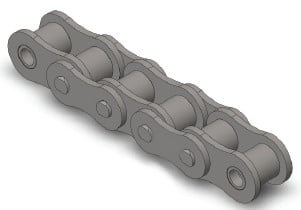Roller chains are 1 from the most effective and cost eff ective strategies to transmit mechanical energy amongst shafts. They operate above a broad choice of speeds, handle huge functioning loads, have quite smaller energy losses and are commonly cheap compared with other strategies
of transmitting electrical power. Successful assortment requires following a number of fairly easy measures involving algebraic calculation and the use of horsepower and services issue tables.
For any given set of drive problems, there are a number of achievable chain/sprocket confi gurations that may efficiently operate. The designer consequently really should be mindful of numerous fundamental variety ideas that when applied accurately, enable balance general drive performance and cost. By following the methods outlined on this section designers must be ready to produce selections that meet the needs on the drive and are price eff ective.
General Roller Chain Drive Rules
? The advisable amount of teeth to the compact sprocket is 15. The minimal is 9 teeth – smoother operation is obtained with extra teeth.
? The recommended optimum quantity of teeth for that significant sprocket is 120. Note that while far more teeth enables for smoother operation acquiring too quite a few teeth prospects to chain jumping off the sprocket after a fairly small level of chain elongation on account of put on – That is certainly chains that has a really big quantity of teeth accommodate less put on prior to the chain will no longer wrap all around them appropriately.
? Speed ratios really should be seven:one or much less (optimum) and not better
than ten:one. For more substantial ratios using a number of chain reductions is advised.
? The recommended minimal wrap with the tiny sprocket is 120°.
? The suggested center distance involving shafts is 30-50 pitches of chain. There are two exceptions to this as follows:
1. The center distance have to be greater compared to the sum in the outside diameters of your driver and driven sprockets to avoid interference.
two. For pace ratios better than three:1 the center distance shouldn’t be less than the outside diameter in  the massive sprocket minus the outdoors diameter from the little sprocket to assure a minimum 120° wrap all around the tiny sprocket.
the massive sprocket minus the outdoors diameter from the little sprocket to assure a minimum 120° wrap all around the tiny sprocket.